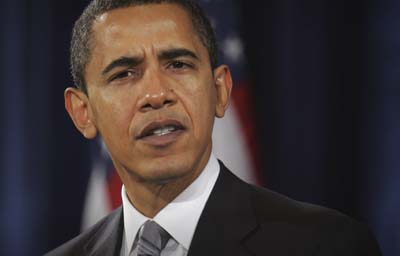PAMELA HESS
WASHINGTON
A released Guantanamo Bay terror detainee has reemerged as an al-Qaida commander in Yemen, highlighting the dilemma facing President Barack Obama in shaping plans to close the detention facility and decide the fates of U.S. captives.
A U.S. counterterror official confirmed Friday that Said Ali al-Shihri, who was jailed in Guantanamo for six years after his capture in Pakistan, has resurfaced as a leader of a Yemeni branch of al-Qaida.
“By Allah, imprisonment only increased our persistence in our principles for which we went out, did jihad for, and were imprisoned for,” he said in a video posted on a militant-leaning Web site Friday. It was the second time this week a reference to al-Shihri has shown up on the Web site. He was mentioned in an online magazine on Jan. 19 with a reference to his prisoner number at Guantanamo, 372.
Al-Shihri was released by the U.S. in 2007 to the Saudi government for rehabilitation. But this week a publication posted on a militant-leaning Web site said he is now the top deputy in “al-Qaida in the Arabian Peninsula,” a Yemeni offshoot of the terror group headed by Osama bin Laden. The group has been implicated in several attacks on the U.S. Embassy in Yemen’s capital Sana.
The announcement from the militant site came the same day that President Barack Obama signed an executive order directing the closure of the jail at Guantanamo Bay, Cuba, within a year.
A key question facing Obama’s new administration is what to do with the 245 prisoners still confined at Guantanamo. That means finding new detention facilities for hard-core prisoners while trying to determine which detainees are harmless enough to release.
According to the Pentagon at least 18 former Guantanamo detainees have “returned to the fight” and another 43 are suspected of resuming terrorist activities. Pentagon spokesman Geoff Morrell declined to provide the identity of the former detainees or what their terrorist activities were.
It is unclear whether al-Shihri’s name would be a new addition to that list of 61.
Al-Shihri is one of a small number of deputies in the Yemeni group, the U.S. counterterror official said. The official spoke on condition of anonymity in order to discuss sensitive intelligence.
The militant Web site referred to al-Shihri under his terror nom de guerre, “Abu Sayyaf al-Shihri.” The video refers to him as “Abu Sufyan al-Azdi al-Shahri.”
An online magazine posted to the The Internet site said al-Shihri is the group’s second-in-command in Yemen. “He managed to leave the land of the two shrines (Saudi Arabia) and join his brothers in al-Qaida,” the statement said.
Included in the site’s material was a message to Yemen’s populace from al-Qaida figure Ayman al-Zawahiri, bin Laden’s top deputy. SITE Intel Group, which monitors extremist Web sites, provided a partial translation of the magazine article and the video.
According to Pentagon documents, al-Shihri was stopped at a Pakistani border crossing in December 2001 with injuries from an airstrike and recuperated at a hospital in Quetta for a month and a half. Within days of leaving the hospital, he became one of the first detainees sent to Guantanamo.
Al-Shihri allegedly traveled to Afghanistan two weeks after the Sept. 11 attacks, provided money to other fighters and trained in urban warfare at a camp north of Kabul, according to a summary of the evidence against him from U.S. military review panels at Guantanamo Bay.
An alleged travel coordinator for al-Qaida, he was also accused of meeting extremists in Mashad, Iran, and briefing them on how to enter Afghanistan, according to the Defense Department documents.
Al-Shihri, however, said he traveled to Iran to buy carpets for his store in Riyadh. He said he felt bin Laden had no business representing Islam, denied any links to terrorism, and expressed interest in rejoining his family in Saudi Arabia.
Yemen is rapidly reemerging as a terrorist battleground and potential base of operations for al-Qaida and is a main concern for U.S. counterterrorism officials. Al-Qaida in Yemen conducted an “unprecedented number of attacks” in 2008 and is likely to be a launching pad for attacks against Saudi Arabia, outgoing CIA Director Michael Hayden said in November.
The most recent attack, in September, killed 16 people. It followed a March mortar attack, and two attacks against Yemen’s presidential compound in late April.
The impoverished country on the southern tip of the Arabian peninsula has a weak central government and a powerful tribal system. That leaves large lawless areas open for terrorist training and operations.
Yemen was also the site of the 2000 USS Cole bombing that killed 17 American sailors. Seventeen suspects in the attack were arrested; ten of them escaped Yemen’s jails in 2003. One of the primary suspects in the attack, Jamal al-Badawi, escaped jail in 2004. He was taken back into custody last fall under pressure from the U.S. government.
Associated Press writer Maggie Michael contributed to this report from Cairo.










